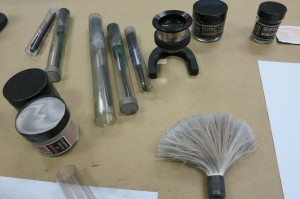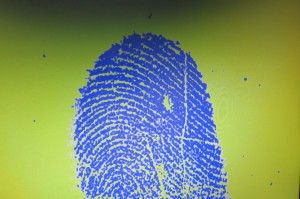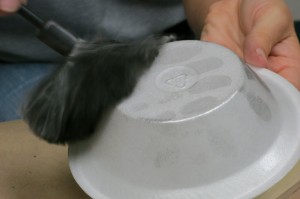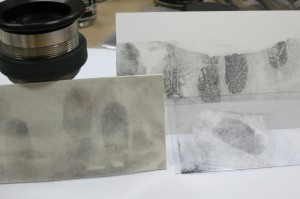KN, p. 71 “Whose fingerprint is that?”
I watched one of the CSI NY television episodes last Friday and was struck, yet again, by the Hollywood look of their crime labs. I like the show because of the actors and some of the cases, but as I’ve said before, TV sets and real life investigations bear little resemblance to each other – not in time, or equipment, or budgets. But, the viewing public expects the local police departments to have all that equipment readily available and is upset with the super long wait for results. It’s called the ‘CSI-effect’ and the guys and gals in real-life law enforcement have to deal with it all the time.
In the real world, investigators and examiners prove a case against the possible suspects using proper evidence collection techniques and tools, with hard work – not flash results in 50 minutes.

Fingerprints found at the scene are still the favored piece of evidence tying the suspect to the crime. These days, using a combination of ingenuity and newly developed chemicals and powders, a crime scene investigator can lift (and/or photograph) prints from many previously challenging surfaces.
After dusting for prints with black fingerprint powder,
they can be lifted from various smooth surfaces using (in forefront) a gel lifter, a hinge lifter and (in background) tape.
Prints are photographed and then can be viewed under an Optical Comparator. This machine can be hooked up to a laptop, and the image sent off to AFIS for ID.

We hope for a complete print, but the usual occurrence is that most of the time, partial prints are left at the scene. That’s what makes the search for the suspects so much tougher than what the TV dramas tell us. There is no instant ‘a-ha’ moment that comes right after the crime has been committed. In a real lab, AFIS comes back with a list of 10-20 possible matches and someone then makes a comparison by hand of the most likely hits.
Some things to keep in mind:
*A print can disappear over time and there are too many variables (temperature, humidity, condition of the surface, etc.) to predict how long that will take.
*A really crisp print can be photographed right at the scene, using some great digital cameras now available.
*Forensic science is not a certainty, even though TV shows may give that impression.
*There is no nationwide standard for number of points of ID for a fingerprint. In the year 2013, the acceptable number of matching points (between the actual print and the print in the AFIS database) can range from 5 to 20 depending on where the suspect lives.
There is no such thing as a perfect crime, but the jails are filled with crooks that swear they have been framed. One of my favorite excuses: “Somebody planted that print.”
Right.
That only happens on TV and in the movies.
*Photos taken by Patti Phillips at the Sirchie Education and Training Center, Youngsville, NC.
KN, p. 71 “Whose fingerprint is that?” Read More »


